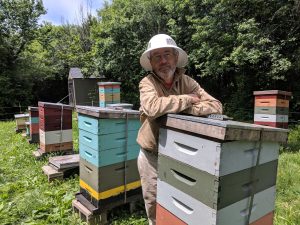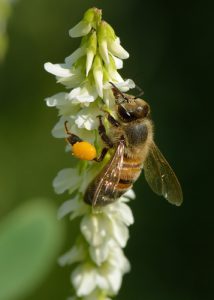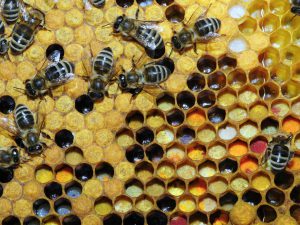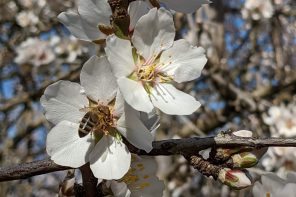Click Here if you listened. We’re trying to gauge interest so only one question is required; however, there is a spot for feedback!
Read along below!

Time to Expect the Unexpected
“Beekeepers commonly claim that during times of nutritional stress or dearth, the queen will stop laying eggs… Unfortunately, this common belief does not appear to be totally accurate.”
By: Ross Conrad
Last season I killed off a perfectly good colony of bees. Not purposely, mind you. Believe me, I thought I was doing what was best for the bees – until I thought again.
It was mid-September when I noticed that a colony in one of my Vermont beeyards had no brood. This is a situation I have gotten somewhat used to. After harvesting the honey supers between the end of August and early September, all the bees get crowded down into the equivalent of two to 2½ deep supers and they sometimes send off a late season swarm. I figure that the part of the colony left behind following these late season swarms have a more difficult time successfully replacing their queen due to the cooler weather, lower drone population and reduced forage that typically occur here in the northeast at that time of year. All too often in September and October, I have seen colonies become queen-less, or turn into drone layers, and I have typically attributed this situation to the poor mating conditions that exist at this time of the season. It’s beekeeping and stuff happens.
Rather than simply let these queenless colonies slowly fizzle out, and possibly get invaded by wax moths, I have always preferred to place any full honey supers from the queenless hive on colonies that could use more honey for Winter. The hive bodies full of bees get temporarily placed on top of the inner covers of colonies that could use a boost in their bee population. As I was breaking this queenless hive up to share its resources between some of the other colonies in the apiary, I noticed that the hive was unusually full of bees. The population was much more than I would expect for a hive that didn’t have a laying queen. Then I saw the queen. She looked perfectly normal. In fact more than normal; she looked good. But I judged her on her performance and there was no brood, and without the ability to raise new workers a colony is doomed.
Now, I don’t normally subscribe to the management style of killing off queens and replacing them, but when combining a colony with a queen that is no good with a queenright hive, I will kill the failed queen just to be sure she doesn’t somehow replace or injure the good queen. This queen was not laying eggs so she had to go.
Then about two and a half weeks later, well into November, the weather finally turned cold enough to kill off the wax moths. I went around removing the empty supers I had stored above the inner covers of my hives to place them in an unheated shed for Winter. I like to go out early in the morning to do this while it is still cold and the bees have not warmed up and broken out of the cluster around the brood nest. This makes taking off the empty supers much easier and faster since I don’t have to light a smoker because the bees are all down below the inner cover and slow to take flight.
My Ah-Ha! Moment
I didn’t think much more about this queenless hive until the holiday season when I ran into another beekeeper and we did what beekeepers tend to do when they get together: we talked about the bees. This beekeeper told me that he had noticed some of his colonies shutting down their brood rearing much earlier in the season than normal. He attributed this to the very dry weather we had experienced late in the Summer and that’s when I got this sinking feeling in the pit of my stomach and realized that it was highly likely that I had destroyed a perfectly good colony of bees.

Science has already determined that in a high carbon dioxide atmosphere, plants on earth produce more carbohydrates and less protein which has resulted in a dramatic decrease in the protein content of pollen over the past century. When this greenhouse-gas induced protein reduction is combined with drought induced protein declines in pollen, the resulting dietary deficiency of protein on honey bee colonies can be severe.
 The Drought Response of Plants
The Drought Response of Plants
The impacts of drought can be much more subtle than the increased incidences of wildfires we have seen around the globe in recent years. Plants in temperate climates typically need much larger quantities of water than bees do, and the negative consequences of dry weather conditions on flowering plants is well documented.
One effect of drought on vegetation is a reduced rate of photosynthesis (Pinheiro and Chaves, 2011), which leads to a reduction of energy available for plants to invest in the production of flowers. This means fewer and smaller blossoms are produced by effected plants (Kuppler & Kotowska, 2021).
When plants are able to produce flowers during drought conditions the blossoms produce less pollen (Waser & Price, 2016) and the pollen produced is more likely to be of low quality with reduced protein content and less reproductively viable (Al-Ghzawi et al., 2009; Rankin et al., 2020; Descamps et al., 2021). Even the scents that flowers use to attract and influence pollinators are impacted by extremely dry conditions (Burkle & Runyon, 2016; Rering et al., 2020).
Nectar production in flowers is likewise negatively impacted by drought. Generally speaking there needs to be water in the soil in order for plants to produce nectar. Reduced water availability is linked to lower nectar volume in flowers (Carroll et al., 2001; Phillips et al., 2018; Gallagher & Campbell, 2017; Halpern et al., 2010; Villarreal & Freeman, 1990). Sometimes, even the sugar concentration of the nectar produced under drought conditions is negatively impacted (Wyatt et al., 1992; Waser & Price, 2016; Rankin et al., 2020).
Droughts Effect on Bees
Since drought conditions cause plants to produce less pollen and nectar and any pollen and nectar that is produced tends to be of lower quality, it is generally accepted that drought conditions result in nutritional stress to honey bee colonies. Beekeepers commonly claim that during times of nutritional stress or dearth, the queen will stop laying eggs. This is commonly observed in northern climates during the Winter months when brood production slows dramatically and often stops altogether during Winter. Unfortunately, this common belief does not appear to be totally accurate.
Back in 2004, Austrian researchers found that in times of nutritional stress the queen does not necessarily stop laying eggs or even reduce her egg laying, but she does reduce her walking activity within the hive (Schmickl & Crailsheim, 2004). The colony response that does appear to be consistent with lack of adequate food availability is that worker bees will cannibalize eggs and larvae to conserve nutrients (Webster et al., 1987). Eggs and middle-aged larvae are the most likely to be cannibalized. This causes the colony’s larvae demographics to change dramatically within days resulting in a rapid decrease in the older larvae population. During nutritional stress events such as those that occur during a prolonged drought, cells containing the oldest larvae are capped earlier for pupation, while the eggs and younger larvae are cannibalized (Schmickl & Crailsheim, 2001). Researchers found that the less pollen stored by the hive during larvae’s development, the earlier the larvae are capped. This is a logical decision by the bees since the oldest uncapped brood represents the greatest investment in brood care resources. Prior to capping, older larvae also have the greatest need for pollen, so by capping their cells early, the colony is able to compensate for a food supply shortage by reducing the young with the greatest demand. This leads to a quick reduction of older unsealed brood in response to a shortage of available protein. If a period of dearth extends long enough, all the capped brood will hatch and there will be no brood left in the hive due to the egg cannibalization efforts of the nurse bees. This explains why my broodless colony had a queen that looked perfectly normal and she was not shrunken and small from a lack of egg production like a virgin queen who has yet to lay eggs.
A Taste of Things to Come
Under climate change, extreme climatic events such as droughts are projected to increase in frequency, duration and severity (IPCC, 2022). In temperate regions, the consequences of water deficit during the peak growing months can be expected to be more severe because drought has not previously been an important environmental factor on plant evolution like it has been in arid regions (Chen et al., 2013).
Current predictions suggest that in temperate zones such as those throughout the northeastern U.S., climate change will increase the frequency of extreme events such as Summer droughts, leading to deficits in water availability for ecosystems. This is expected to result in plants more often experiencing water stress during the Spring and Summer. As beekeepers we need to be conscious of the fact that the current pace of climate destabilization will continue to accelerate due to our slow transition away from fossil fuels, rampant consumerism and materialism. This will cause our honey bee colonies to behave differently than what we have grown used to during previously more climate stable times.
I definitely learn more from my mistakes than from my successes. In sharing this experience, I am reminded that we all have something we can teach others, even if we only act as a stellar example of what not to do.
Ross Conrad is the author of Natural Beekeeping: Organic Approaches to Modern Apiculture and coauthor of The Land of Milk and Honey: A history of beekeeping in Vermont.
References:
Al-Ghzawi, A.A.M., Zaitoun, S., Gosheh, H., Alqudah, A. (2009) Impacts of drought on pollination of Trigonella moabitica (Fabaceae) via bee visitations, Archives of Agronomy and Soil Science, 55(6): 683-692
Burkle, L.A. & Runyon, J.B. (2016) Drought and leaf herbivory influence floral volatiles and pollinator attraction, Global Change Biology, 22: 1644-1654
Carroll, A.B., Pallardy, S.G., Galen, C. (2001) Drought stress, plant water status, and floral trait expression in fireweed, Epilobium angustifolium (Onagraceae), American Journal of Botany, 88(3): 438-446
Chen, T., van der Werf, G.R., de Jeu, R.A.M., Wang, G., Dolman, A.J. (2013) A global analysis of the impact of drought on net primary productivity, Hydrology and Earth System Sciences, 17: 3885–3894, https://doi.org/10.5194/hess-17-3885-2013
Descamps, C., Quinet, M., Jacquemart, A.L. (2021) The effects of drought on plant-pollinator interactions: What to expect? Environmental and Experimental Botany, 182: 014297
Gallagher, M.K. & Campbell, D.R. (2017) Shifts in water availability mediate plant-pollinator interactions, New Phytologist, 215(2): 792-802
Halpern, S.L., Adler, L.S., Wink, M. (2010) Leaf herbivory and drought stress affect floral attractive and defensive traits in Nicotiana quadrivalvis, Oecologia, 163: 961-971
IPCC – International Panel on Climate Change (2022) IPCC Sixth Assessment Report: Impacts, Adaptation and Vulnerability, https://www.ipcc.ch/report/ar6/wg2/
Kuppler, J. & Kotowska, M.M. (2021) A meta-analysis of responses in floral traits and flower-visitor interactions to water deficit, Global Change Biology, 27(13): 2095-3108
Phillips, B. B., Shaw, R. F., Holland, M. J., Fry, E. L., Bardgett, R. D., Bullock, J. M., Osborne, J. L. (2018) Drought reduces floral resources for pollinators, Global Change Biology
Pinheiro, C. & Chaves, M.M. (2011) Photosynthesis and drought: Can we make metabolic connections from available data? Journal of Experimental Botany, 62: 869-882
Rankin, E. E. W., Barney, S. K., Lozano, G. E. (2020) Reduced water negatively impacts social bee survival and productivity via shifts in floral nutrition, Journal of Insect Science, 20(5): 15
Rering, C.C., Franco, J.G., Yeater, K.M., Mallinger, R.E. (2020) Drought stress alters floral voatiles and reduces floral rewards, pollinator activity, and seed set in a global plant, Ecosphere, 11(9)
Schmickl, T. & Crailsheim, K. (2001) Cannibalism and early capping: strategies of honey bee colonies in times of experimental pollen shortages, Journal of Comparative Physiology A, 187: 541-547
Schmickl, T. & Crailsheim, K. (2004) Inner nest homeostasis in a changing environment with special emphasis on honey bee brood nursing and pollen supply, Apidologie, 35: 249-263
Villarreal, A.G. & Freeman, C.E. (1990) Effects of temperature and water stress on some floral nectar characteristics in Ipomopsis longiflora (Polemoniaceae) under controlled conditions, Botanical Gazette, University of Chicago Press
Webster, T.C., Peng, Y.S., Duffey, S.S. (1987) Conservation of nutrients in larval tissue by cannibalizing honey bees, Physiological Entomology, 12(2): 225-231
Waser, N. M., Price, M. V. (2016) Drought, pollen and nectar availability, and pollination success, Ecology, https://doi.org/10.1890/15-1423.1
Wyatt, R., Broyles, S.B., Derda, G.S. (1992) Environmental influences on nectar production in milkweeds (Asclepias syriaca and A. exaltata), American Journal of Botany, 79(6):636-642








